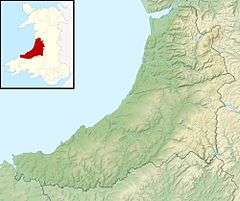Glandyfi Castle
Glandyfi Castle in Glandyfi, Ceredigion, Wales, is a mock castle dating from the early 19th century. It was built for George Jeffreys, High Sheriff of Cardiganshire in 1819, whose great-uncle, Edward, had purchased the estate in 1792. The architect is not known, although John Hiram Haycock has been suggested. Jeffreys and his wife were friends of Thomas Love Peacock, the novelist and poet, whose wedding took place at the castle in 1820. In the 20th century, the castle was bought by the BSA motorcycles corporation, for the use of its chairman, Sir Bernard Docker. His, and his wife's, use of company funds to restore the property led to criticism from shareholders and the subsequent sale of the castle. As of April 2020, the castle is again on the market. It is a Grade II listed building.
| Glandyfi Castle | |
|---|---|
.jpg) "a Georgian country house in picturesque castellated style" | |
| Type | House |
| Location | Glandyfi, Ceredigion |
| Coordinates | 52.5523°N 3.9302°W |
| Built | 1812 |
| Architectural style(s) | Mock castle |
| Governing body | Privately owned |
Listed Building – Grade II | |
| Official name: Glandyfi Castle | |
| Designated | 21 January 1964 |
| Reference no. | 9874 |
Listed Building – Grade II | |
| Official name: Gatepiers to Glandyfi Castle | |
| Designated | 23 November 2004 |
| Reference no. | 83263 |
 Location of Glandyfi Castle in Ceredigion | |
History
The Jeffreys were originally from Shrewsbury and had moved to Ceredigion (then Cardiganshire) in the mid-18th century to develop lead smelting mills. Edward Jeffreys bought the Ynyshir estate, which included the site of the present castle, in 1792.[1] He died in 1801, his son Robert died in 1802, and his other son, another Edward, was killed in the Peninsular War in 1812. The estate therefore passed to his brother, George, a lawyer, who began to build the castle immediately on his inheritance.[1] In 1819 Jeffreys was made High Sheriff of Cardiganshire and the following year his close friend, Thomas Love Peacock, married Jane Griffith, an event celebrated by their reception at the castle.[1] Jeffreys died in 1868 and the death of his second son, Charles, in 1906 saw the sale of Glandyfi. In the first half of the 20th century it passed through various owners until bought by BSA in 1949. Bernard Docker and his second wife, Norah Collins, were known for their extravagant lifestyles, generally funded from the assets of Docker's companies, rather than their own. Their profligacy saw Docker's abrupt removal from the chairmanship of BSA, and the sale of Glandyfi, in 1956.[lower-alpha 1][3][2] The castle was later used as an hotel, a wedding venue and a bed-and-breakfast establishment.[4] As of April 2020, the castle is for sale.[5]
Architecture and description
The Agrarian and Industrial revolutions of the mid-18th century saw the emergence of Gothic Revival architecture, which began to challenge the dominance of the Baroque.[6] This saw an explosion of castle-building; notable examples within Wales were Penrhyn in the north and Cyfartha in the south. Glandyfi is on a much smaller scale, but stands comparison with Stanage Park at Knighton, just over the border in Powys.[7] Stanage was designed by John Hiram Haycock and the connections are such that Pevsner suggests Haycock as the architect for Glandyfi,[7] although Cadw notes the lack of documentary evidence to support this.[1]
The castle consists of a two-storey central block, with a three-storey tower to the left and a large buttress to the right. A dining room and a small tower are later additions.[7] Battlements crenellate the whole. The interior contains imported wood panelling. The castle is a Grade II listed building, its listing record noting that it is "the only example [of a] Georgian country house in picturesque castellated style in the county".[1]
A Country Life magazine report in spring 2020 indicated that the house was then "a ten-bedroom, ten-bathroom, five-reception room home" with "medieval-style atrium".[8]
Notes
- A later owner of Glandyfi recorded the reaction of local people to the Dockers' extravagance: "The older people around here who remember them say they were unbelievable, almost mythical figures. At a time when everyone else was still on rationing, the Dockers were thundering through the lanes in limousines made out of gold and silver."[2]
References
- Cadw. "Glandyfi Castle (Grade II) (9874)". National Historic Assets of Wales. Retrieved 9 April 2020.
- "Luxury post-war limo is auctioned". September 13, 2014 – via www.bbc.co.uk.
- Ashworth, Anne. "Glandyfi, a Welsh Castle for Party Lovers". www.mansionglobal.com.
- Ridout, Joanne (June 6, 2019). "You could live in a Welsh castle which is up for sale for £2.8m". walesonline.
- "Glandyfi Castle". Rightmove.co.uk.
- Macauley 1975, p. 1.
- Lloyd, Orbach & Scourfield 2006, p. 471.
- A dreamlike castle for sale set on a hillside overlooking a sweep of river in one of the most beautiful areas of Britain
Sources
- Lloyd, Thomas; Orbach, Julian; Scourfield, Robert (2006). Carmarthenshire and Ceredigion. The Buildings of Wales. New Haven, US and London: Yale University Press. ISBN 978-0-300-10179-9.
- Macaulay, James (1975). The Gothic Revival 1745–1845. Glasgow and London: Blackie. ISBN 9780216898929.